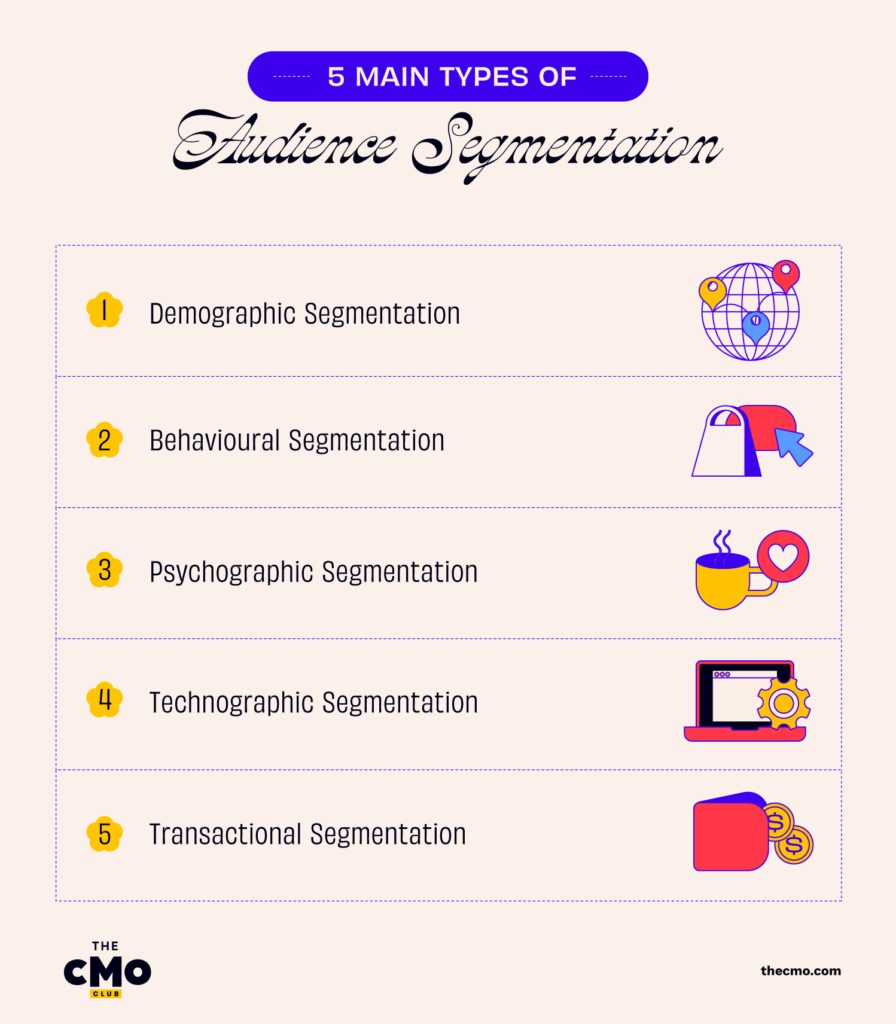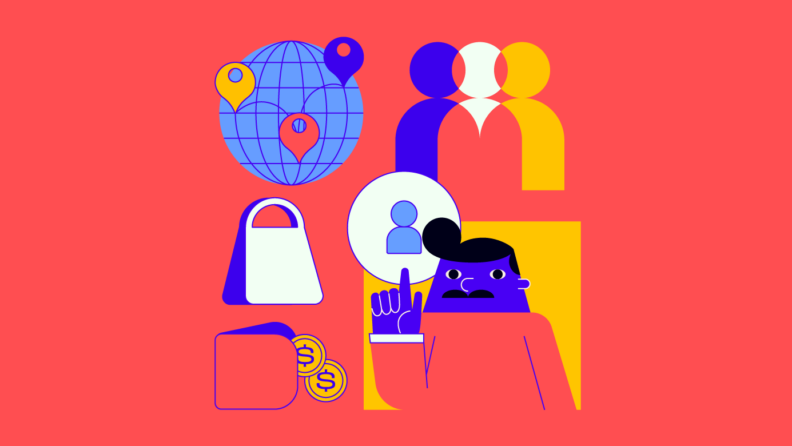In today's hyper-competitive market, understanding your customers on a deep, granular level is absolutely essential. Generic, one-size-fits-all marketing campaigns simply won't cut it when you're battling for the attention of increasingly discerning and tech-savvy buyers.
That's where audience segmentation comes in. By breaking down your customer base into distinct groups, you can develop highly personalized ads and strategies that speak directly to the unique needs, behaviors, and preferences of each segment. The result? Campaigns that cut through the noise, drive stronger engagement, and deliver measurable business impact.
In this guide, I’ll share the different types of audience segmentation and provide practical ways you can use customer data to elevate your targeting.
What Is Audience Segmentation?
Audience segmentation is the process of dividing your overall customer base into distinct, targeted groups based on shared characteristics and behaviors.
This strategic approach is especially crucial in an account-based marketing (ABM) context. By segmenting your highest-value target account list and the key decision-makers within them, you can craft hyper-targeted outreach and messaging that actually resonates.
Similar to how there's different types of market segmentation, the illustration below demonstrates how audience segmentation allows you to break down your broader customer base into more defined groups. This enables you to develop tailored marketing tactics, content, and even experiences for each segment, rather than taking a one-size-fits-all approach.

Why Is Audience Segmentation Important?
Audience segmentation is a critical component of account-based marketing strategies, as it makes your ABM personalization efforts possible. By dividing your customer base and using laser targeting, you unlock a wealth of benefits that can drive measurable business impact.
According to the Data & Marketing Association (DMA), segmented campaigns see as much as a 760% increase in revenue compared to generic, one-size-fits-all marketing. Going further, statistics show marketing leaders have found 77% of their ROI came from segmented, targeted, and triggered email campaigns. It’s no surprise then that personalized experiences driven by target audience insights can boost customer satisfaction.
Types Of Audience Segmentation

Demographic segmentation
Demographic segmentation divides audiences based on characteristics like age, gender, income, occupation, education level, and family status. For example, a SaaS HR platform may target HR managers aged 35-45 with 5-10 years of experience and a budget of $50k-$100k.
Psychographic segmentation
Psychographic segmentation focuses on the internal attributes that shape a customer's attitudes, values, interests, and lifestyle. This could include personality traits, hobbies, social class, and cultural influences. A project management SaaS might target ambitious, detail-oriented professionals who value work-life balance.
Behavioral segmentation
Behavioral segmentation analyzes how customers interact with and use a product or service. This includes factors like purchase history, content engagement, feature usage, and subscription plans. An accounting software brand may segment users based on their invoicing frequency and adoption of automation features.
Technographic segmentation
Technographic segmentation focuses on the technologies and tools used by customers, such as CRM platforms, marketing software, and development frameworks. This helps tailor product integrations and messaging for tech-savvy audiences.
Transactional segmentation
Transactional segmentation groups customers based on their purchasing behavior and patterns, such as order frequency, average order value, and customer lifetime value. An e-commerce brand may offer loyalty programs or VIP experiences for their highest-spending, most loyal customers.
Firmographic segmentation
Firmographic segmentation applies to B2B audiences, categorizing companies based on attributes like industry, company size, revenue, and number of employees. A B2B cybersecurity solution could target Fortune 500 enterprises in the finance and healthcare sectors.
Buyer journey
Buyer or customer journey segmentation aligns messaging and content with the different stages of the sales funnel, from awareness to consideration to decision. This ensures you're delivering the right information at the right time to nurture leads and drive conversions.
How To Segment Your Audience

Effectively segmenting your audience is a strategic, data-driven process that requires a methodical approach. But don't worry, there's marketing segmentation software that can help. Here are the key steps to follow:
1. Collect audience information
The first step is to gather as much relevant data about your customers as possible. This includes information you may already have access to, like:
- Customer Profile Data: Leverage your marketing CRM software, marketing automation software, and marketing analytics tools to extract demographic, firmographic, and transactional details about your customers, like age, gender, location, industry, company size, and purchase history.
- Behavioral Analytics: Analyze customer interactions across your website, mobile app, and other digital touchpoints. Track metrics like content engagement, feature usage, and conversion rates to identify behavioral patterns.
- Survey and Interview Feedback: Conduct customer surveys, both quantitative and qualitative, to uncover deeper insights into their preferences, pain points, and decision-making criteria. Supplement this with one-on-one interviews for rich, contextual information.
- Social Listening: Use social listening tools to monitor social media conversations, reviews, and industry forums to gain visibility into how your customers and prospects are discussing your brand and products.
- Industry Research: Leverage third-party market research, competitive intelligence, and industry benchmarks to contextualize your audience data and identify relevant segmentation variables.
2. Determine segmentation criteria
Next, analyze the data you've collected and identify the key variables that differentiate your customers. As you’ll recall from the different types of segmentation I explained, common segmentation criteria to consider include:
- Socio-Demographic Factors: Age, gender, income, education level, occupation, family status
- Geographic Location: Country, state, city, urban vs. rural, language
- Behavioral Patterns: Purchase frequency, feature usage, content engagement, subscription plans
- Psychographic Attributes: Values, interests, pain points, decision-making styles, personality traits
- Firmographic Details: Industry, company size, revenue, number of employees
Decide which of these factors are most relevant and impactful for your specific business goals and customer base. You may want to start with 2-3 key segmentation variables, then expand from there as you test and optimize.
3. Segment audiences, test, and iterate
With your segmentation criteria defined, you can now divide your overall audience into distinct, meaningful groups. Start by creating broad different segments, then further refine and validate them through testing and iterative optimization.
- Analyze Segment Characteristics: Assess the size and growth of potential customers, and distinct needs of each segment. Develop detailed buyer personas that bring the segments to life.
- Test Segment-Specific Strategies: Experiment with tailored messaging, content, offers, and channel preferences for each audience group. Monitor campaign performance and conversion metrics.
- Continuously Optimize: Regularly review and adjust your segmentation based on changing customer behaviors, market dynamics, and business priorities. Leverage A/B testing and analytics to inform ongoing refinements.
- Align Cross-Functional Team: Ensure sales, customer success, product, and other key stakeholders are aligned on your audience segments and their distinct characteristics. This cross-functional collaboration will enhance the customer experience.
Where To Use An Audience Segmentation Strategy
Audience segmentation can be leveraged across a variety of digital marketing channels and strategies to drive stronger results. Some of these include:
- Account-based marketing (ABM): Use behavioral segmentation to segment your high-value target accounts and key decision-makers to craft hyper-personalized outreach and experiences, regardless of the type of ABM you choose.
- Social media marketing: Use audience segmentation to optimize your targeting, content marketing, and ad creative for each unique social media platform and user demographic.
- Email marketing: Deliver personalized email campaigns and nurture sequences tailored to the specific needs and behaviors of your segmented email lists.
- PPC marketing: Leverage audience segmentation to refine your ad targeting, messaging, and bidding strategies for maximum efficiency and ROI.
- Direct mail marketing: Segment your physical mailing list by location, industry, purchase history, or other relevant criteria to boost response rates.
Tips And Best Practices For Audience Segmentation
As you implement an audience segmentation strategy, keep this in mind:
Avoid segmenting too deeply
It's important to strike a balance between hyper-targeted segmentation and maintaining sufficient scale. Going too narrow with your audience members can limit your overall reach and impact. Start with 3-5 core segments, then gradually expand or refine as needed.
Tailor messaging for each segment
Once you've defined your specific audience segments, craft distinct messaging, content, and offers that speak directly to the unique needs, pain points, and preferences of each group. Avoid a one-size-fits-all approach.
Use different channels
Different audience segments may respond better to certain marketing channels over others. Leverage a multichannel strategy, optimizing your approach for the specific behaviors and preferences of each segment across email, social media, website, direct mail, and more.
Set goals and measure results
Establish clear, measurable objectives for your segmentation efforts, whether that's increased conversion rates, higher customer lifetime value, or faster sales cycle times. Continuously track and analyze the performance of your segment-specific campaigns to inform ongoing optimization.
Join For More Targeted Insights
By using audience segmentation and dividing your customers into groups based on shared characteristics and behaviors, you will be able to create highly personalized marketing strategies and experiences that drive stronger engagement, conversion, and retention.
To help the concept stick, let me leave you with these three key takeaways:
- Effective audience segmentation unlocks a wealth of benefits, from increased conversions and customer lifetime value to improved lead generation and accelerated growth.
- There are numerous segmentation approaches to consider, including demographic, psychographic, behavioral, firmographic, and transactional - each offering unique insights to enhance your marketing efforts.
- Following a systematic approach to audience segmentation, from data point collection to iterative testing, is crucial for developing segment-specific strategies that resonate with your target customers.
If you're looking to take your audience segmentation to new heights and unlock even more targeted insights, be sure to subscribe to the CMO newsletter.


